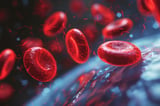Breakthrough Study: Red Blood Cells Play Key Role in Blood Clot Contraction, Challenging Traditional Views
August 24, 2025
The osmotic depletion effect causes red blood cells to pack tightly, exerting mechanical forces on the fibrin network and leading to stronger clot formation, independent of platelet activity.
Further experiments confirmed that osmotic depletion, rather than cell surface bridging, is the primary mechanism driving red blood cell aggregation within clots.
The study also ruled out the 'bridging' effect as a major contributor, establishing osmotic depletion as the main process behind red blood cell-driven clot contraction.
A groundbreaking study from the University of Pennsylvania reveals that red blood cells actively contribute to clot contraction, challenging the traditional view that only platelets are responsible for this process.
Experiments demonstrated that blood clots lacking platelets still significantly shrank, indicating that red blood cells play a direct and vital role in strengthening and stabilizing blood clots by shrinking and packing tightly within the fibrin mesh.
Understanding this new role of red blood cells could lead to innovative treatments for clotting disorders like thrombocytopenia and improve prevention strategies for strokes and embolisms.
Gaining insights into how red blood cells influence clot formation and breakdown may pave the way for better therapies for bleeding and clotting disorders.
Researcher Prashant Purohit developed a mechanical model suggesting that osmotic depletion primarily causes red blood cells to be compacted within the fibrin mesh, pushing cells together and strengthening the clot.
Published in Blood Advances, the study shows that red blood cells help enhance clot stability by contracting and tightly packing within the fibrin network, contributing to overall clot contraction.
This process involves proteins in the surrounding fluid creating osmotic pressure differences that pull red blood cells closer, transferring mechanical forces to the fibrin network and resulting in more robust clots.
Summary based on 2 sources
Get a daily email with more Science stories
Sources

SciTechDaily • Aug 16, 2025
400 Years After Their Discovery, Red Blood Cells Continue To Astonish Scientists
ana.press • Aug 24, 2025
Red Blood Cells Continue to Astonish Scientists